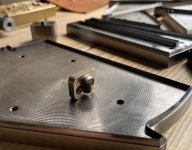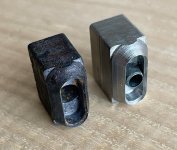Hello,
I started a CNC business now 7 years ago, in the begining making just Policarbonate and textolite parts, but after a few years I purchased an Tormach Mill, to be able to make cutting dies for leather, I use 1.2379 tool steel for all my cutting dies.
For hardening , until now we worked with a local old man that used to "harden" by heating just the top of the blade using a welding torch, but now we want to fully harden the parts better, the entire part, not just the top of the blade.
We got for tests an home made oven, from a guy that makes blades for knives, we can set the temperature as we need but after cooling in oil, on the surface of the cutting dies appears an black crust, I want to find a way to clean that crust without doing it by had, and the first thing that I was thinking was un ULTRASONIC CLEANER, do you guys think that might work ?
Those are some cutting dies I made, the small one on top of the bigger one, is hardened in a factory, in pressure controlled chambers, hence the yellowish color, sometime we get them in blueish color, but it's complicated for us to harden in that factory as they have about 1 week lead time.

If I could remove easily / automatically the crust on the dies, my problem would be solved.
thank you
I started a CNC business now 7 years ago, in the begining making just Policarbonate and textolite parts, but after a few years I purchased an Tormach Mill, to be able to make cutting dies for leather, I use 1.2379 tool steel for all my cutting dies.
For hardening , until now we worked with a local old man that used to "harden" by heating just the top of the blade using a welding torch, but now we want to fully harden the parts better, the entire part, not just the top of the blade.
We got for tests an home made oven, from a guy that makes blades for knives, we can set the temperature as we need but after cooling in oil, on the surface of the cutting dies appears an black crust, I want to find a way to clean that crust without doing it by had, and the first thing that I was thinking was un ULTRASONIC CLEANER, do you guys think that might work ?
Those are some cutting dies I made, the small one on top of the bigger one, is hardened in a factory, in pressure controlled chambers, hence the yellowish color, sometime we get them in blueish color, but it's complicated for us to harden in that factory as they have about 1 week lead time.

If I could remove easily / automatically the crust on the dies, my problem would be solved.
thank you






